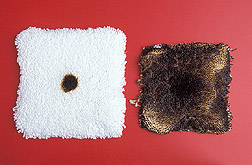This page has been archived and is being provided for reference purposes only. The page is no longer being updated, and therefore, links on the page may be invalid.
|
Read the magazine story to find out more. |
Researchers Flame-Proof Cotton CarpetingBy Jan SuszkiwApril 10, 2002 Demand for cotton-based carpeting and rugs, a $10-billion market dominated by synthetic fibers such as nylon, polypropylene or polyester, could improve because of a new flame-retarding treatment developed by Agricultural Research Service scientists. Cotton's backseat status to synthetic fibers as a floor covering material stems from burning characteristics that often prevent it from meeting federal standards for surface flammability. Although numerous commercial flame retardants are available for treating cotton, many aren't cost effective for practical use on all-cotton or cotton/polyester carpeting materials, notes Eugene Blanchard, a chemist with ARS' Cotton Textile Chemistry Unit in New Orleans, La. There, he and ARS chemist Elena Graves overcame the problem by treating cotton carpeting with nontoxic chemicals called polycarboxylic acids. They chose the chemicals for their low cost, availability, absence of formaldehyde, lack of toxicity and reactivity with cotton fibers to impart flame resistance. For test purposes, scientists subject the treated carpeting to 10 wash cycles with detergent before drying it in preparation for the methenamine pill test. This involves placing a 12- by 12-inch carpet sample onto a 9- by 9-inch metal frame with an 8-inch diameter hole in the center. A methenamine tablet is then placed there and ignited. Cotton-based carpeting with a low-density cut pile surface normally burns beyond the allowed range (to within one inch of the hole's edge). In fact, such burning often chars the sample's entire surface. On the treated carpeting, however, the flame's spread is restricted to less than one inch from the ignition point. Technically, the flame could spread another two inches and the sample would still pass the test, adds Blanchard, who co-published a paper in the January 2002 issue of Textile Research. Use of the treatment could help U.S. cotton capture a greater share of the carpeting market, which consumes five billion bales of synthetic fibers annually. A more detailed story on the research appears in the April issue of Agricultural Research magazine. ARS is the U.S. Department of Agriculture's chief scientific research agency. |

